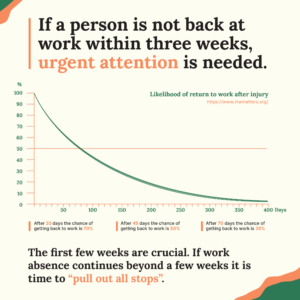Here’s a number to make you sit up: 72 days. That’s the average time an injured worker in New Zealand is off work, receiving weekly compensation. Even worse, over 65% of those days are signed as fully unfit, meaning workers are completely away from the workplace for an average of 46 days according to 2024 ACC data (https://bpac.org.nz/2024/docs/recovery-work.pdf)
And medical certificates? The average length they’re signed for? 24 days at a time, that’s over three weeks in between medical reviews to monitor recovery and assess changing work capacity
Is this good healthcare? Or is it just delaying recovery, draining resources, and setting everyone up for more problems down the line?
The True Cost of Long Absences from Work
Injuries aren’t just a physical issue—they ripple through workplaces, families, and bank accounts.
- Financial strain – Whether your business is under the ACC Accredited Employer Scheme or the standard ACC Experience Rating scheme, long injury absences cost you. Either you’re paying weekly compensation directly, or you’re feeling the sting later through increased ACC levies directly related to your lost time days the previous year.
- Mental health struggles – The longer someone is off work, the greater the risk of isolation, depression, and anxiety. Work isn’t just about a pay check—it’s a connection to purpose and routine.
- Social impact – When a worker is off for months, it doesn’t just affect them. It affects their family, their team, and their employer trying to plug the gap.
So, are we really okay with an average of six weeks off per injury as the status quo?
What Can You Do About It?
Simple: Get a doctor on your rehab team.
An Occupational Health doctor isn’t just another medical tick-box. They’re the key to good care for workers that leads to better recovery, lower costs, and a smoother return-to-work process. Here’s how:
- Early intervention – Early occupational health medical assessment after injury for a thorough assessment and an informed medical certificate which supports a structured return-to-work plans prevent delays and unnecessary time off.
- Workplace knowledge for targeted support – A doctor who understands work environments and has the time to assess a workers injury and bigger picture health issues can spot red flags early to target interventions— Often pain management issues, mental health concerns, or social barriers significantly slow recovery more than purely injury related issues.
- Stronger relationships – A workplace doctor isn’t working in isolation. They collaborate with physios, employers, and workers to help everyone remain on the same page. Regular medical reviews can also help identify and support challenges as they arise to keep recovery on track.
Avoiding the Long-Term Fallout
It’s a proven fact that the longer someone is off work, the harder it is to get them back. Statistics show that the likelihood of a full return to work after six weeks off work “fully unfit” is 50% and progressively declines to less than 20% at six month so the first few weeks are crucial.
Occupational Health doctors assess not just the injury, but the worker’s overall health, work environment, and personal circumstances to create a realistic return-to-work plan. They identify and tackle obstacles before they become long-term problems—reducing the risk of permanent disability, chronic pain, and mental health decline.
Bottom Line: Act Early, Avoid the Cost
When a worker gets injured, what happens next determines everything.
- Get it wrong, and you’re looking at months off work, mounting costs, and a frustrated worker stuck in limbo. At this point, the odds of a full return to work drop significantly.
- Get it right—with early medical assessment, proper support, and a doctor leading the rehab process—and workers recover faster, stay engaged, and return to work with fewer complications.
So the real question is: Can you afford not to have a doctor in your rehab team?
Contact Injury Doc NZ now on admin@injurydoc.nz to support your workers recovery while the odds are in your favour
ACC Injury Recovery Statistics – Reference 2024 ACC data for workplace injury recovery times.

Comments (0)